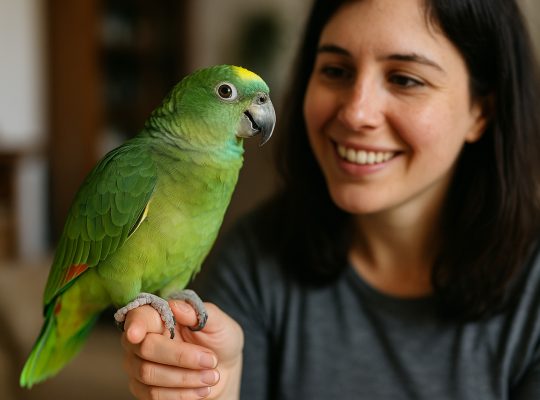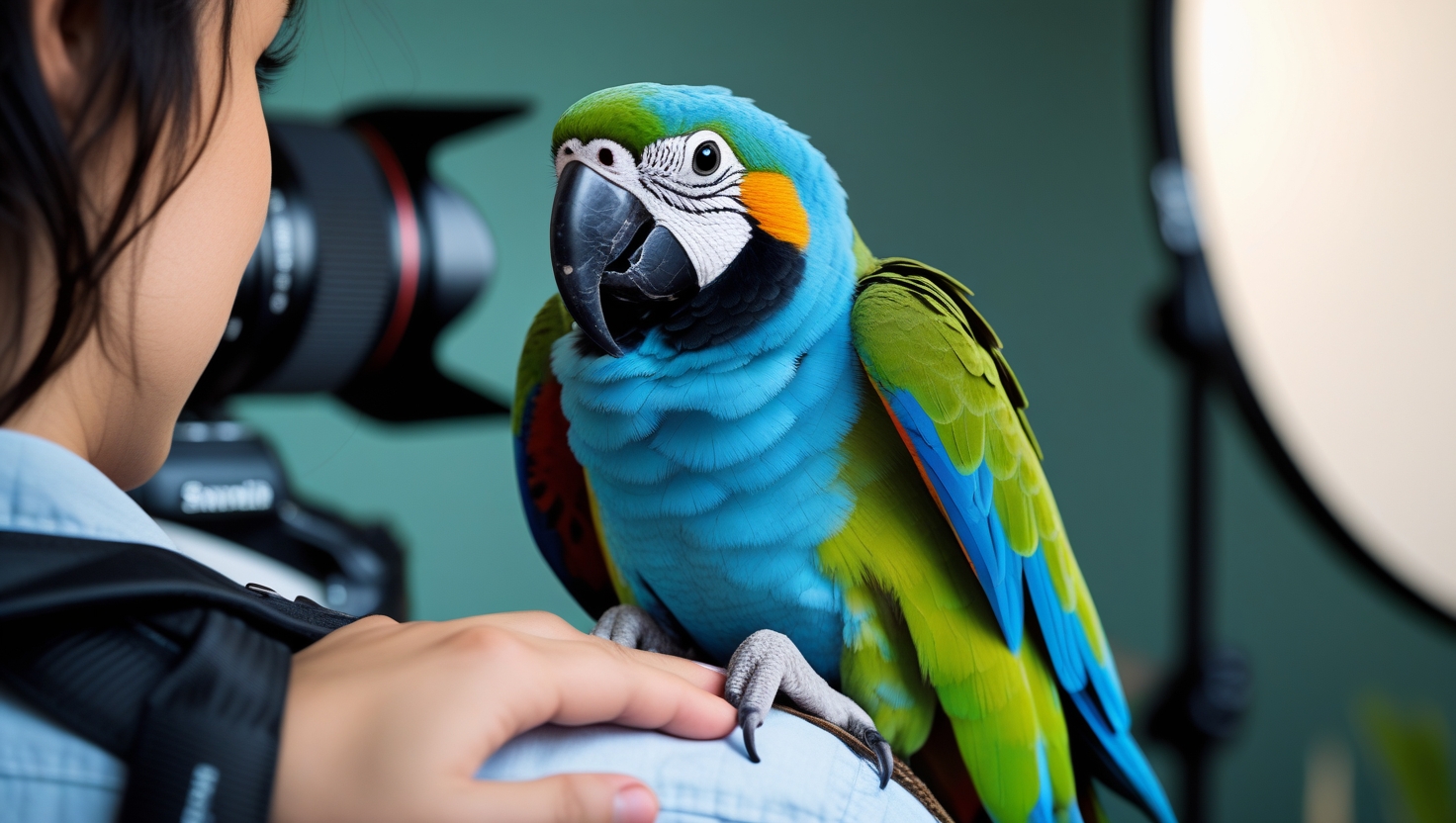Parrots are vibrant, intelligent, and social birds, but they are also prone to several health concerns. Recognizing symptoms early and implementing preventive measures can help maintain their well-being. Below are common health issues parrots face and practical steps to prevent them.
1. Malnutrition
Symptoms:
- Dull or brittle feathers
- Weakness and lethargy
- Overgrown beak or nails
- Poor appetite
Causes:
Many parrots suffer from poor nutrition due to seed-only diets. While seeds provide some nutrients, they lack essential vitamins and minerals.
Prevention:
- Offer a balanced diet with fresh vegetables, fruits, high-quality pellets, and limited seeds.
- Avoid processed foods, high-fat snacks, and excessive sugary treats.
- Provide a cuttlebone or mineral block to support calcium intake.
2. Psittacosis (Parrot Fever)
Symptoms:
- Watery droppings
- Breathing difficulties
- Swollen eyes
- Lack of energy
Causes:
This bacterial infection spreads through airborne particles from droppings, saliva, and feather dust. It is contagious to other birds and even humans.
Prevention:
- Maintain a clean living environment, removing droppings and dust regularly.
- Ensure proper ventilation in cages and play areas.
- Quarantine new birds before introducing them to existing ones.
- Schedule regular veterinary check-ups.
3. Feather Plucking
Symptoms:
- Bald patches
- Constant preening
- Self-mutilation
Causes:
Stress, boredom, poor nutrition, and medical issues can lead to feather plucking. Lack of mental stimulation and social interaction can also trigger this behavior.
Prevention:
- Provide toys, foraging activities, and out-of-cage time to prevent boredom.
- Maintain a consistent routine to reduce stress.
- Ensure a balanced diet to support healthy feather growth.
- Rule out medical conditions with a vet if plucking persists.
4. Respiratory Infections
Symptoms:
- Wheezing or clicking sounds when breathing
- Sneezing with nasal discharge
- Open-mouth breathing
- Tail bobbing
Causes:
Dust, mold, smoke, and poor ventilation contribute to respiratory problems. Parrots have sensitive respiratory systems, making them highly vulnerable to airborne irritants.
Prevention:
- Keep the living space free of smoke, aerosols, and strong scents.
- Regularly clean cages, perches, and food bowls.
- Use proper ventilation and avoid drafts.
- Provide a humidifier if the air is too dry.
5. Beak and Feather Disease (PBFD)
Symptoms:
- Feather loss
- Overgrown or deformed beak
- Weakness
- Weight loss
Causes:
PBFD is a viral infection affecting the immune system, leading to feather loss and beak abnormalities. It spreads through feather dust, droppings, and direct contact.
Prevention:
- Quarantine new birds before introducing them to others.
- Keep cages, toys, and feeding areas sanitized.
- Avoid exposure to infected birds.
- Consult a vet if signs appear, as PBFD has no cure.
6. Obesity
Symptoms:
- Excessive weight gain
- Difficulty flying
- Lethargy
- Fat deposits on the chest or abdomen
Causes:
High-fat diets, lack of exercise, and overfeeding contribute to obesity. Birds kept in small cages without enough movement are at higher risk.
Prevention:
- Offer a balanced diet rich in fresh produce and pellets.
- Limit high-fat seeds and treats.
- Encourage physical activity with climbing toys and foraging opportunities.
- Allow regular out-of-cage flying time.
7. Egg Binding (For Female Parrots)
Symptoms:
- Straining or difficulty laying eggs
- Swollen abdomen
- Weakness
- Sitting at the bottom of the cage
Causes:
Egg binding occurs when a bird cannot pass an egg, often due to calcium deficiency, poor diet, or stress.
Prevention:
- Provide a diet rich in calcium, such as dark leafy greens and cuttlebone.
- Ensure proper hydration and exercise.
- Reduce excessive light exposure to prevent overproduction of eggs.
- Seek immediate veterinary care if a bird struggles to lay an egg.
8. Vitamin A Deficiency
Symptoms:
- Swollen or crusty nostrils
- White plaques inside the mouth
- Poor feather condition
- Lethargy
Causes:
A seed-heavy diet lacking fresh produce leads to vitamin A deficiency, affecting the immune system and respiratory health.
Prevention:
- Include carrots, sweet potatoes, bell peppers, and leafy greens in meals.
- Offer vitamin A supplements if needed (under veterinary guidance).
- Rotate food varieties to maintain a diverse nutrient intake.
9. Bumblefoot
Symptoms:
- Swollen, red, or sore feet
- Difficulty perching
- Lameness
Causes:
Bumblefoot results from rough or unsuitable perches, obesity, or prolonged standing on hard surfaces.
Prevention:
- Provide a mix of perch sizes and textures to prevent pressure sores.
- Keep perches and cage floors clean.
- Ensure proper diet and exercise to maintain healthy weight.
10. Crop Infections (Sour Crop)
Symptoms:
- Regurgitation
- Swollen crop (area below the beak)
- Foul-smelling breath
- Loss of appetite
Causes:
Fungal or bacterial infections in the crop can result from poor hygiene, feeding improper foods, or sudden dietary changes.
Prevention:
- Clean feeding dishes daily.
- Avoid feeding cold or spoiled food.
- Ensure a gradual transition when changing diets.
- Seek veterinary treatment if symptoms arise.
Final Thoughts
Parrots rely on consistent care, a clean environment, and a proper diet to stay healthy. Preventative measures such as routine vet check-ups, mental stimulation, and proper nutrition go a long way in avoiding serious health problems. Keeping an eye on behavior changes and physical signs ensures a proactive approach to a long and healthy life.





